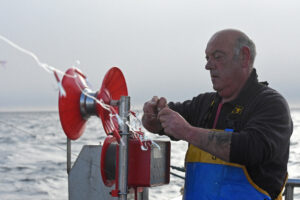Static-gear boats in North East Scotland have engaged in inshore mackerel fishing in recent weeks
A chance meeting outside Peterhead fishmarket with static-gear skipper Andrew Buchan led to the much-appreciated offer of a few hours on the 9m Twinseas catamaran Progress PD 25 the following morning, reports David Linkie
I’ll be down at the boat for 5am, but as the fishing is very patchy, there might be little or no action to photograph. Time will tell,” was the friendly warning.
Not knowing when another opportunity might come along, Andrew’s offer was too good to miss, fish or no fish.
A week earlier, the first light catches of line-caught mackerel, in most instances little more than a couple of boxes, had been landed by local boats as June drew to a close. Although skippers had kept trying, fish had continued to be scarce, particularly in shallower water close to the shore, where the majority of mackerel are usually taken during the short summer season.
Lower than average sea temperatures, following a prolonged winter, were thought to be a contributing factor to the considerably slower and later start than normal.
This possibility was borne out by the fact that boats from harbours like Pennan, Gardenstown, Macduff, Whitehills, Portsoy and Cullen, fishing in the Moray Firth, where the water was thought to be slightly warmer, due to the hot sunny conditions that were prevailing ashore, had started to see more encouraging signs of increased activity.

Skipper Andrew Buchan rigging a new trace of hooks on the…
The previous morning, skipper Andrew Buchan had caught a few boxes of mackerel between hauling leaders of creels, so the fish were starting to show on occasion.
Ironically, after days of scorching sun and very light winds, conditions were changing as Progress headed two miles into the northeast, after crossing Peterhead bay and clearing the breakwaters, towards where seven local boats were jigging in a fairly compact area.
In freshening conditions, Andrew Buchan activated the two Belitronic BJ5000 EX jigging machines mounted towards the quarters above the stainless steel safety rails.
Spooled with extremely strong and lightweight Dyneema steel-thread backing line, each reel fishes a 200lb nylon trace tied with 40 mackerel hooks, spaced 9in apart, culminating in a 5kg lead weight on a 1m-long strop.
From the reels, the lines lead forward to two free-running rollers positioned on the wheelhouse roof. From there, they double back to a second set of rollers located outboard above the mackerel strippers. The two-tier forward rollers ensure that the hooks are kept clear of each other at all times. The strippers are positioned on the end of short fish chutes pivoted in line with the gunwale.
Apart from minor variations, in line with the requirements of individual skippers and their boats, and in some instances the number of machines fitted, jigging arrangements on Progress mirror those on most inshore boats in northeast Scotland.

… 9m Twinseas catamaran Progress PD 25.
Operating in immediate retrieve mode in 30 fathoms of water, the tension reading, displayed on a spectrum bar and digitally on the jigging machines, continually hovered around the no-fish level, despite several shifts of ground as skipper Andrew Buchan worked to improve the situation.
With the other boats experiencing a similar scarcity, at the same time as a strengthening northwesterly wind brought the first in a series of some unexpected rain squalls, it was not surprising when some skippers speaking on the VHF said they were making for in.
A few minutes later, a call from one skipper who had steamed into the southwest, closer inshore south of Buchan Ness lighthouse, reporting more signs of mackerel, saw those boats still at sea steaming towards his location.
Initially, the move yielded some fish on the flies, although perhaps not in the quantities that the marks shown on the Koden CVS-128 indicated might have been possible.
Although the tension reading on the jigging machines occasionally moved into the low thirties, indicating the possibility of six to eight mackerel on the line, fishing remained sporadic at best for the next two hours, including slack water and the first of the ebb, which on another day can prove productive.
By now some three miles south of Peterhead, and with the tide running against the wind creating more jabble on top of the water, Andrew Buchan called time on a morning that had produced a slack box of mackerel.
Returning for another go that evening yielded a further two boxes. Together with line-caught mackerel from the local fleet and some Moray Firth boats, these were sold on Peterhead fishmarket the following morning.

Prosperity Be heading for harbour on a morning of rapidly changeable weather.
While the decision by the Scottish government to set an annual quota of 1,000t for the inshore mackerel fishery following a successful three-year pilot scheme (Fishing News, 19 April) brings enhanced stability for fishermen and buyers alike, and gives the continuity required to further develop valuable niche markets, inshore mackerel remains a fickle fishery at best.
Throughout July and the first week of August, catches off the Buchan coast generally continued to be sporadic. A run of southerly and southeasterly winds also curtailed effort at times, although giving more favourable conditions west of Kinnaird Head into the Moray Firth, where the early-season trend of better returns was continued.
Market prices have also fluctuated considerably at times, in response to supply levels and trade holidays, when some processors have reduced filling capacity.
Following an early-season peak of £200 per box (50kg), when line-caught mackerel were in extremely short supply, prices initially settled at around £1.80. After briefly dropping to a seasonal low of £1-£1.20 per kg, prices quickly recovered to £2-£2.80 in the first week of August.








